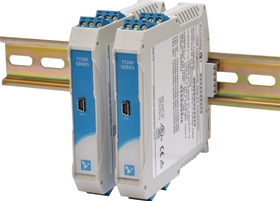

The Acromag TT330 series of 4-wire process transmitters are isolated signal conditioners supporting high-density mounting on DIN rails and providing a convenient USB connection to a PC for simple, precise configuration using Windows software.
Several models are available to convert a variety of thermocouple, voltage or current input signal types to a choice of bipolar or unipolar ranges for proportional voltage or current output signals. Wiring terminals are front-facing and removable for easy connections and maintenance.
The process signal converters are DC-powered (12–32 V) and support a bussed rail power option for primary or redundant power. The rugged design features -40°C to +80°C operation, electrical noise immunity and surge protection. CE and UL/cUL Class 1 Division 2 Zone 2 hazardous location approvals are pending.
Each model accommodates a variety of signal types selected in the configuration software. The thermocouple model accepts eight different sensor types (J, K, T, R, S, E, B, N) as well as ±100 mV inputs. A DC current input model can condition ±1 mA, ±20 mA, 0-20 mA or 4–20 mA input ranges, as well as ±0,5 V d.c. and even 0–20 A a.c. with an external toroidal sensor. There are also low-voltage (±1 V, ±5 V, ±10 V) and high-voltage (±15 V, ±75 V, ±150 V) d.c. input models.
All units can convert the input to a ±10 V, ±5 V, 0–5 V, 0–10 V, ±20 mA, 0–20 mA or 4–20 mA output. The software also allows precise scaling of input ranges for full resolution. Input/output values can be tested and calibrated in the software.
The USB-to-PC connection for software-driven configuration provides advantages over DIP switches that can only offer coarse range settings, and also over trim pots that allow fine tuning but require far more time to achieve the desirable results.
With a USB port, you can digitally set the calibration gain and offset using precision D/A converters whereas DIP switches and pots can change values over time or due to temperature/shock/vibration. These changes can lead to drift and require periodic recalibration.
Once configured, the device’s settings can be archived in a file or uploaded into additional units for rapid cloning in large systems. Later, a device’s USB port enables diagnostic communication using software. USB-configured devices also use fewer mechanical parts which increases long-term reliability.
All TT330 models withstand 50 G shock and 5 G vibration to deliver dependable operation in hostile environments. They are built to AS9100 aerospace and ISO 9001 certified quality control standards and are backed by a 7-year warranty.
| Tel: | +27 11 795 9500 |
| Email: | [email protected] |
| www: | www.allpronix.com |
| Articles: | More information and articles about Allpronix |

© Technews Publishing (Pty) Ltd | All Rights Reserved